In this post I have explained how a neat little self regulating automatic battery charger circuit can be made using just two inexpensive transistors.
This circuit will automatically regulate the charging supply to the battery depending on its charge level, by switching the input supply ON and OFF periodically.
How it Works
As can be seen in the diagram, this auto-regulating battery charger circuit utilizes just two transistors for detecting the charging thresholds, and cuts off the process as soon as these limits are detected.
Using two transistor actually makes the design hugely sensitive compared to a single transistor charger circuit.
The indicated preset is set in such a way that the T1 is just able to conduct at the specified full charge threshold of the battery.
When this happens T2 begins switching OFF, and ultimately at a point it is unable to sustain the relay conduction and switches OFF the relay, which in turn cuts of the input charging source with the connected battery.
Conversely, when the battery voltage begins dropping, T1 gradually deprived of its adequate conduction voltage level, and ultimately it ceases to conduct, which quickly prompts T2 to initiate its conduction and trigger the relay into action,
The relay now reconnects the charging input supply with the battery, and restores the charging process until it yet again reaches the full charge threshold, when the regulating cycle repeats itself.
How to Sep Up the Circuit
Setting up this battery charger circuit for automatic regulation is very simple and may be done in the following way:
- Initially, do not connect the fixed transformer power supply; instead connect a 0-24V, variable supply voltage to the circuit.
- Remove the anode of D6 from the relay contact and connect it to the positive of the power supply.
- Keep both the presets somewhere at the center position.
- Switch ON the power and adjust the voltage to 11.5 volts or lower.
- Adjust P2, so that the relay just activates.
- Now increase the volts to about 13.5 volts, and adjust P1 so that the relay just deactivates.
The setting procedure of the circuit is now complete.
Check the whole procedure by continuously varying the voltage up and down.
You may now remove the variable power supply and connect the fixed transformer, bridge power supply to it.
DON’T FORGET TO RECONNECT THE ANODE OF D6 BACK TO THE RELAY CONTACT OR THE BATTERY POSITIVE.
The battery connected to this circuit will be charged only as long as its voltage is in between the above "window" level.
If the battery voltage crosses the above "window", the relay will trip and stop the battery from charging.
Parts List
- R1, R2 = 10K = 2
- P1, P2 = 10K PRESET = 2
- T1, T2 = BC 547B = 2
- C1 = 2200uF/25V = 1
- C2 = 47uF/25V (Please connect this capacitor across the relay coil) = 1
- D1---D4 = 1N5408 = 4
- D5, D6 = 1N4007 = 2
- RELAY = 12 VOLT, SPDT = 1
- TRANSFORMER = 1, (AS PER THE CONNECTED BATTERY AH (DIVIDE BY 5)

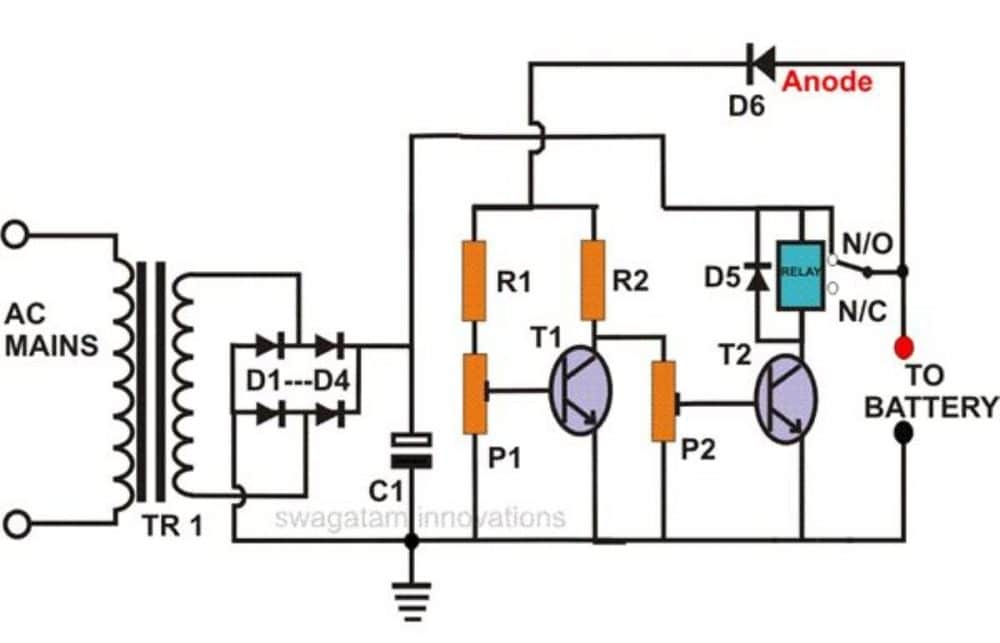
The following diagram shows the instructions which needs to be followed while setting-up the circuit with the desired cut-of thresholds, using a variable power supply unit:
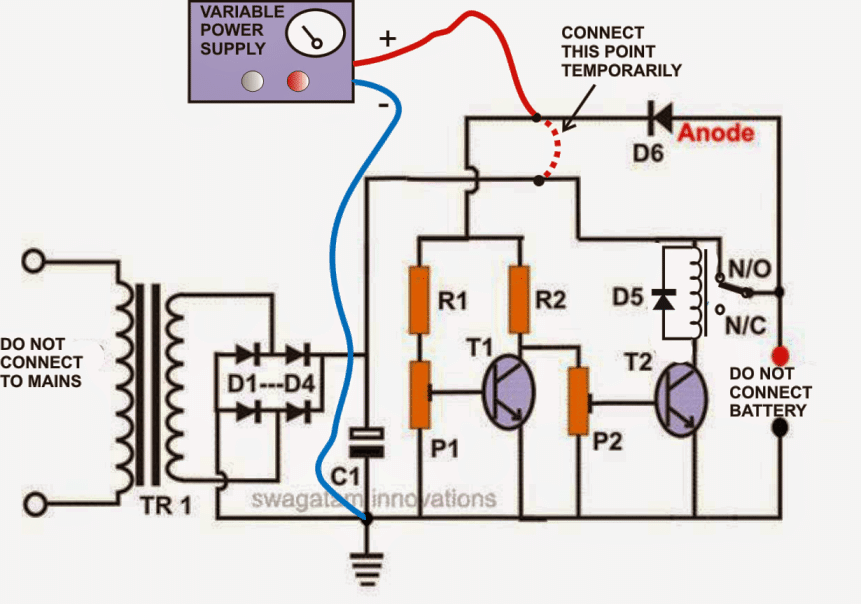
The above self-regulating battery charger circuit was successfully built and tested by Mr. Sai Srinivas, who is just a school kid but nevertheless has an immense interest in the field of electronics.
The following images were sent by him which displays his talent and intense dedication in the field.
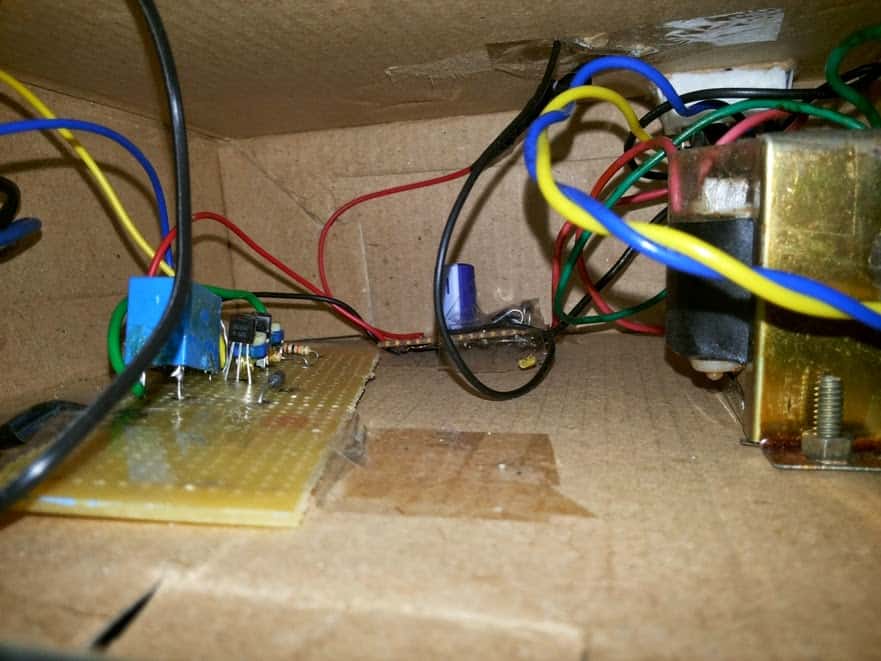
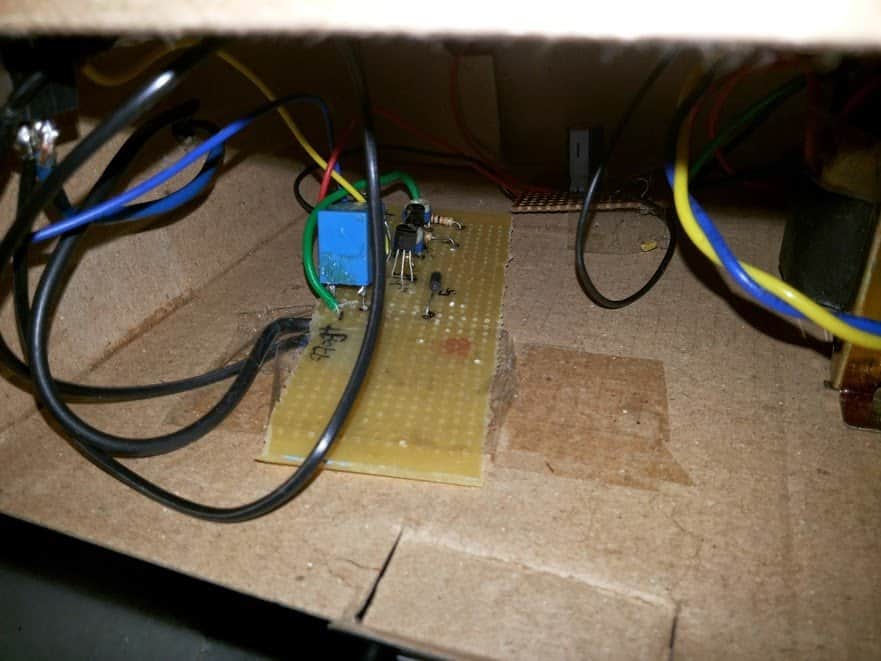
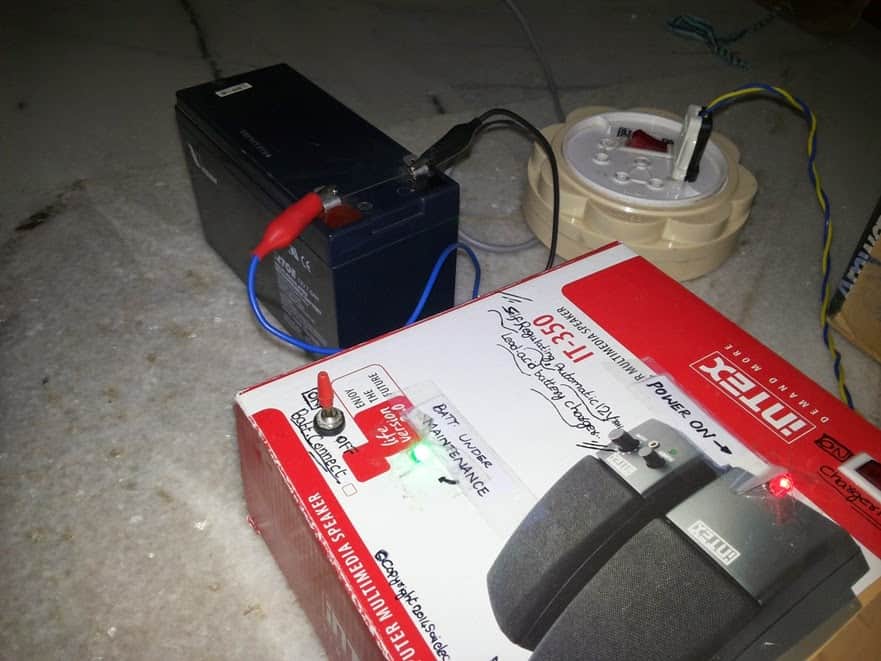
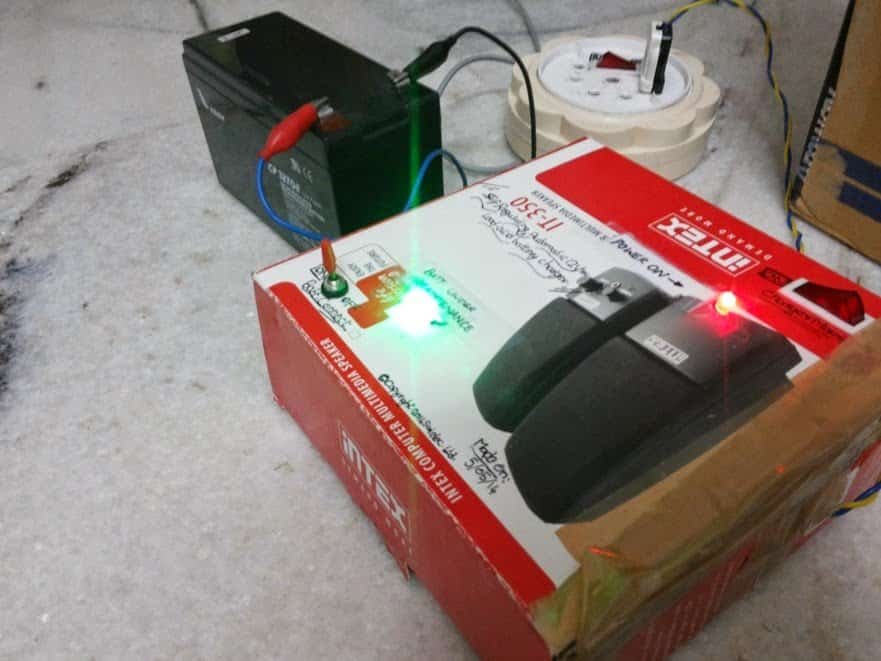
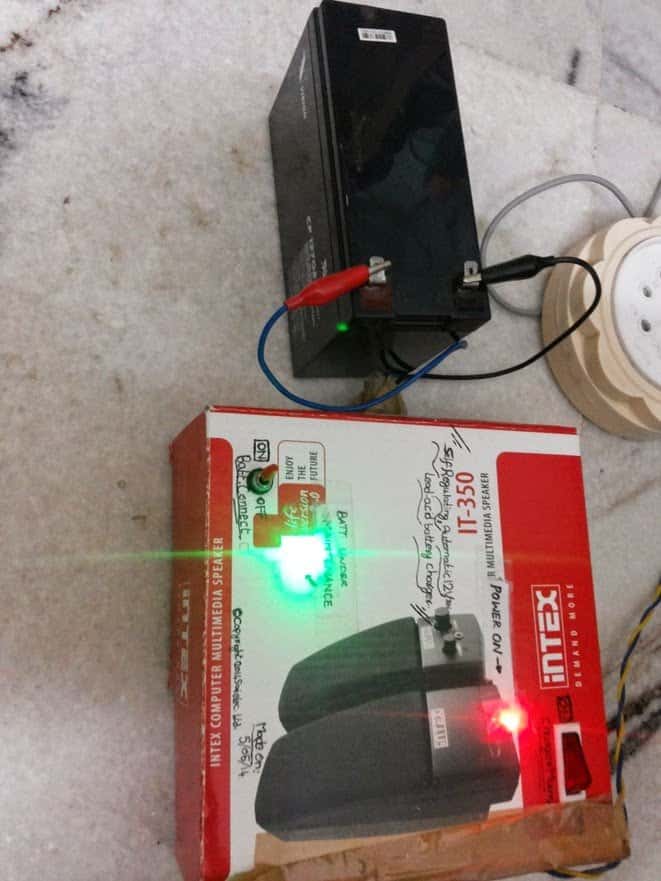
For One Shot Operation
If you want the above circuit to lock itself into a permanent cut off position when the battery is fully charged, then you may modify the design as shown below:
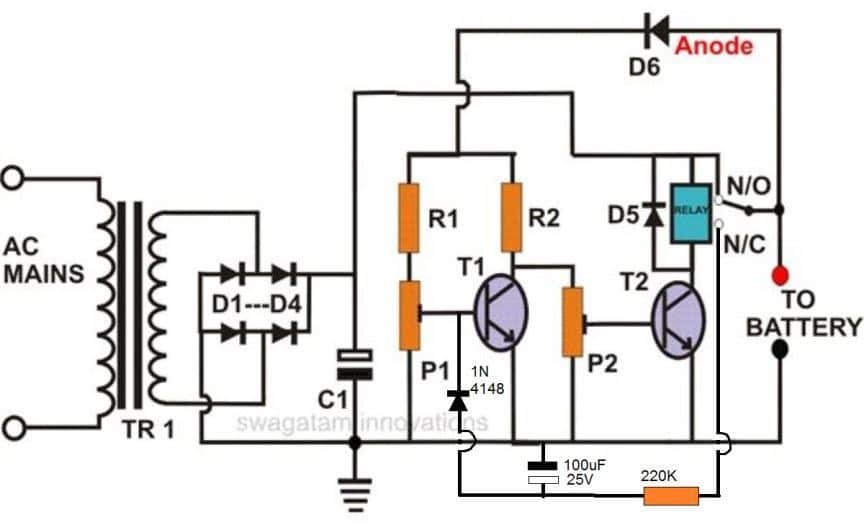
Note: To ensure the relay does not latch itself quickly on power switch ON, always connect the discharged battery first across the shown terminals and then switch ON the input power.
In order to indicate the charging status of the battery, we can add a couple of LEDs to the above design, as shown below.
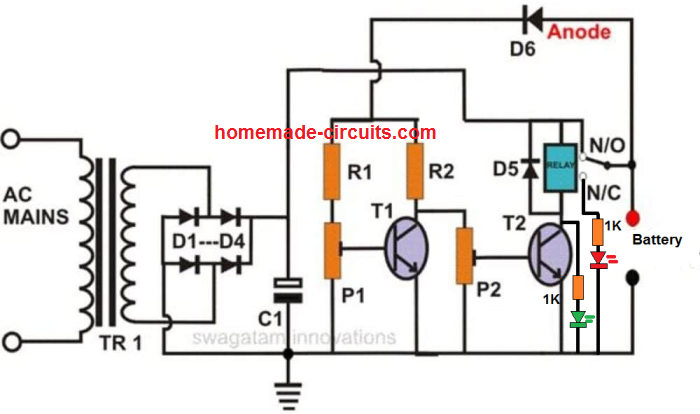
The above circuit was also successfully built and tested by one of the dedicated electronic enthusiasts from this blog. The following pictures verify the results:
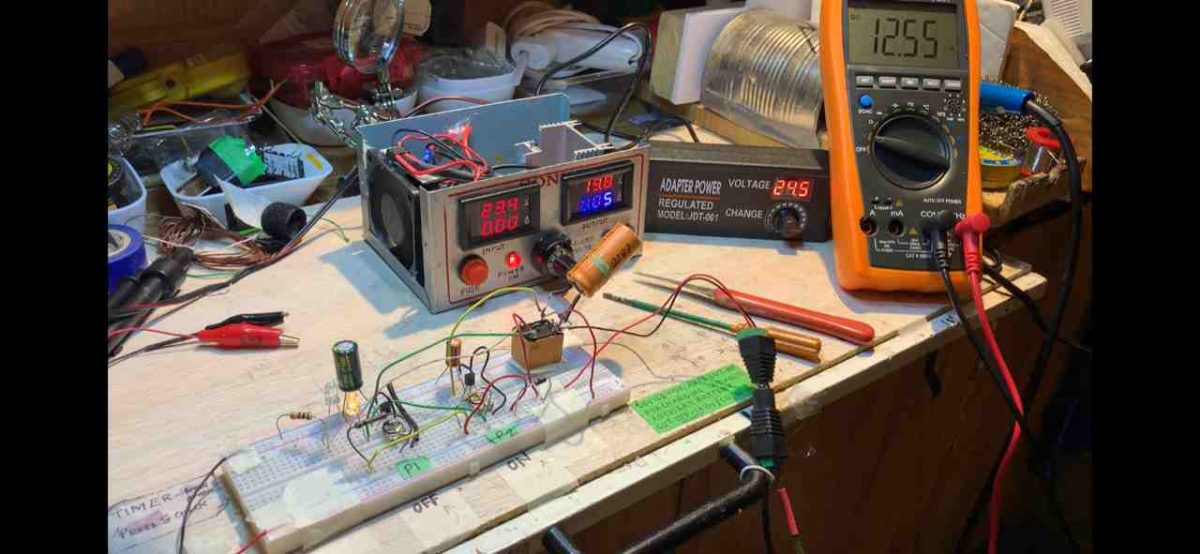
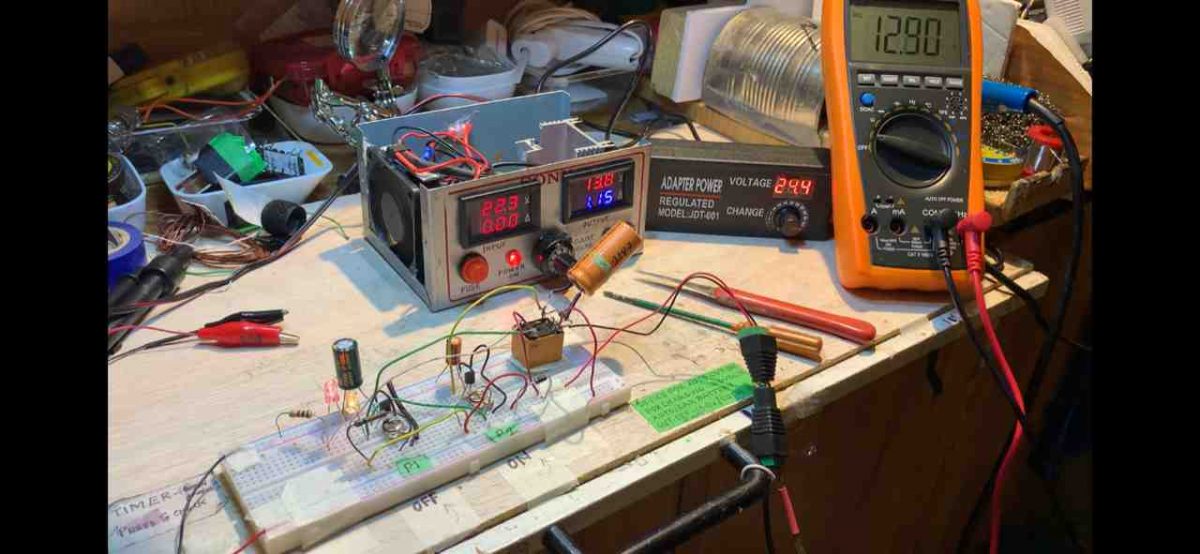
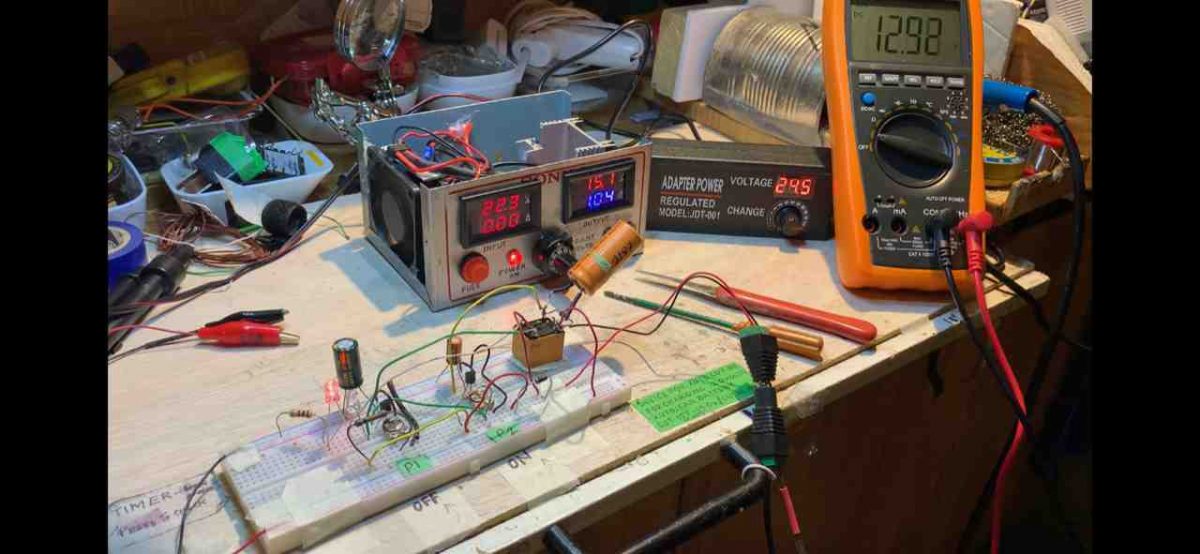
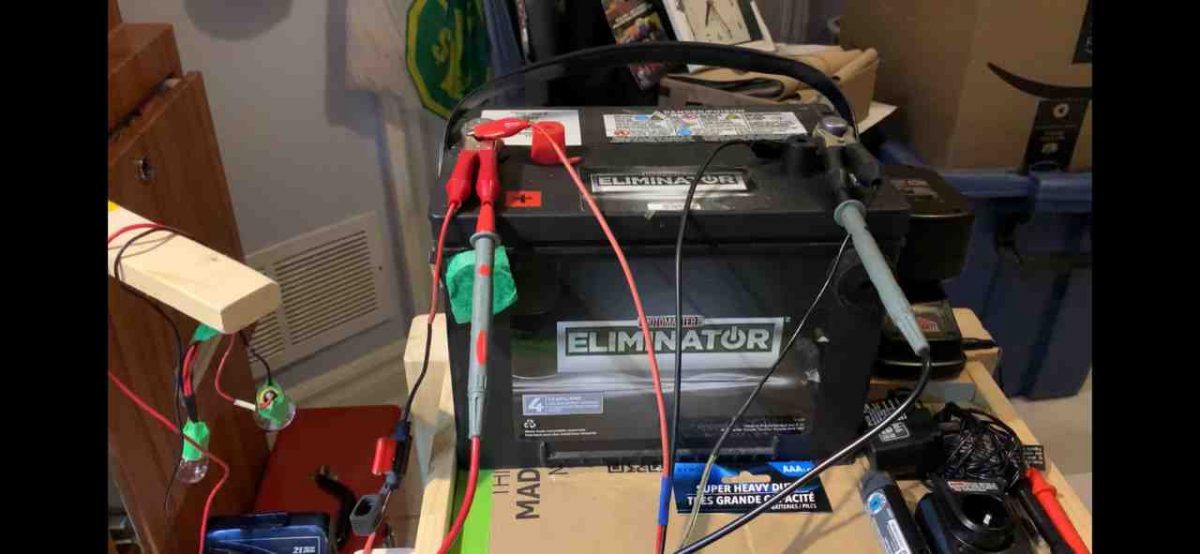
Warning: Make sure to test the preset setting thoroughly before you leave this application unattended. And be sure to use only 14V as the input supply for a 12V battery.

I got this circuit working.
It seems this device would be best used as a battery shut off if one didn't want one to discharge below a fixed voltage.
To be any use as advertised it would have to latch off at the high end and come on again at the low setting.
Used on a working battery it would spend most of it's time rapidly turning on and off maintaining the high value. Might as well use hydro in that case.
It might be useful providing a float at a lower voltage, would keep the relay busy with all that on and off business, though.
"Make this 48V Automatic Battery Charger Circuit" might fill the bill. I'll give it a try.
https://www.homemade-circuits.com/2012/08/make-this-48v-automatic-battery-charger.html
Thanks
Carl
Thanks for the update Carl, appreciate it a lot!!
yes, it will keep ticking at the threshold within a margin of 0.5V. that's the reason I named it as "self regulating" 🙂
it can be used at the lower switch-OF threshold or at the upper full charge threshold, depends on how the relay contacts are wired.
however to introduce a hysteresis feature you can experiment by adding a resistor from one of the relay contacts to the base of T2…as already discussed with Mr. Tim in my earlier comments…
BTY in Canada we call those presets, cermets
OK…got it.
Swagatam my man, do you build each of these circuits or do you run some of them on a simulator program?
If you run a program which one would you recommend, also is there a good free one?
Carl
Hi Carl, I never use simulators for checking my designs, to me those are just useless…I rely entirely on my mind simulation…which has been so far 99% correct, although the final result on some occasions require a bit of serious tweaking.
Mind simulation is what Tesla used….good for you…..It sure served him well.
Carl
yep, thanks Carl…
Could someone re-work this circuit so that one could plug any 12v charger into it and have it sense the battery voltage and turn the charger on and off as per the hi/low presets.
Carl
you can use the above circuit with any 12V charger input, once the preset is set it will respond to all charger inputs identically
Sir honestly speaking i have try the settings for the past 2hrs now, one setting always offset the other what I'm looking at doing is to use two relay one will be for cutoff while the other will be to trigger will this work please your advice is needed
Thanks and best Regards
Faith, try the last circuit from this article, for a low voltage actuation:
https://www.homemade-circuits.com/2013/05/low-battery-indicator-circuit-using-two.html
and connect a feedback resistor from the collector of BC557 to the base of central BC547…this will determine the high voltage actuation of the relay…
remember here the BC557 will need to upgraded for your 70 amp relay or if possible try with a smaller relay and confirm the results first
And yes but T1 and T2 are Tip22
use any small NPN for T12 such as BC547..and use a higher amp NPN for T2 such as a 2N2222 or D880 or 8050 etc so that it is able to handle the high current for the 70 amp relay coil….
TIP122 may not be required actually
In one the comments i read u said they should connect 820k from the N/C open to the base of T1 and also connect high value from the base of t1 to ground which of them should i try because my relay is 4 pin relay i.e its only normally open there is no normally close please advise me what to do
It can be implemented to latch the circuit and create a desired gap between the high cut off and low restore points. But it is not required if the setting is done correctly through the given presets, and this is not difficult not at all if done with proper understanding and using good quality parts…I have tested this circuit, and for me it was just a matter of 10 minutes
Sir i hv building but setting it is a little problem when i set one side it off set the orther
I fail to mention the relay i bought is 70amp 4pin it normally open relay can i use it in place of 5pin i.e one N/C and N/O
Faith, Please keep trying you will succeed…refer to the comments for the details…
make sure the T2 is appropriately rated to handle the 70 amp relay coil….use a TIP122 if possible for T2
I got 70amp relay today can be ok for the 12v@600amp
you can try it….it should work…
Sir please i want ask is there to regulate the voltage going to relay because if 16v which is coming from my transformer gose to relay won't it burn the relay
Thanks
Faith, 16V could be a little high, you can put a few series diodes with the relay coil to drop it, however the connected discharged battery would quickly get it down to its charge level so ultimately it won't have any impact on the relay coil….
I wil like to make this one but getting a 100amp relay is the problem here while i wil keep searching for a 100amp relay can you kindly give me the address to others. I think it won't be difficult for me
Thanks being regard
if 100 amp relay becomes problem, you can try a mosfet for the cut off, as presented in the first diagram of this article
https://www.homemade-circuits.com/2012/08/make-this-48v-automatic-battery-charger.html
Thanks for reply actually i did not press the Load more button. sir concerning this circuit can i use it for a 12v@600AH if yes how do i increase the transistors in other to increase the current
If this circuit wont work for that can you please give me a good and working circuit i can use for 12v@600AH battery i really i want to make a good charger for my batteries
Thanks for help
Faith, the above circuit is extremely good and fully automatic, here the relay charges the battery not the transistors, transistors only control the relay operations. you can use it for your battery, but make sure the relay is able to handle 100amp current…and use a TIP122 for the relay driver transistor T2….other designs are also present in the website which use opamps and can be even more difficult for you to make and adjust…
Can it be use for 9v battery?
& what is the output voltage and output current
yes, but the relay will also need to be 9V rated, current and volts will as per the input supply
Hi, friend this ia Gery simple but good idea and very Cheap self charging controller.
thank you friend!
Hi engineer, pls how can I integrate this charger into automatic changeover inverter because the positive line of the battery is connected to relay. when it trips off, there can't be contact on battery.also, at 13.5v the battery can't be fully charge because within 30mins of charging the battery will get to 13.9v with a good charger. what is the meaning of the self regulating. thanks for all your invaluable assistance.
Atinuke, for automatic mains to inverter changeover you will more relays attached in the supply lines.
you can chage the battery to 14.4V also, there's no restrictions.
self regulating means the relay will go on tripping ON/OFF between two small thresholds say 13V and 14V to keep the battery perfectly charged and in topped up condition.
Thank u sir…..
Hai sir….
I have some ?
Cut off voltage of 12v,6v,4v and 24v lead acid battery….
For 12v I'm using 10+3.6v=13.6v zener
For 6v I'm using 6.8v zener
But 4v and 24v battery i do no the cut off value …so pls guide me sir…
Hi Kesave, which circuit are you referring to?
anyway for 24V you can use a 28V zener
and for 4V use a 4.7V zener
Very nice circuit. Cheap, easy to make and it really works !!! The only part that needs attenmtion is the setup of the cut off voltages … but if somebody reads carefully the instructions and try 1 – 2 times then it is a success !!!
Thank you very much for this post! I wonder if i can make it work for charging 24V 14Ah batterfy … but i think it worths a try …
Many greetings and thank you again !!!
Thank you very much Ilias, I am glad you could understand and adapt the design correctly. I appreciate it very much.
yes definitely, through minor modifications this design could be used for 24V or in fact any other preferred voltage operations.
Hi Papan, the two resistors which I suggested are different.
The relay pin configuration will depend on its type and brand….you can refer to the following article which shows the pinout configuration of one of the common types of relay, which you can also use
https://www.homemade-circuits.com/2012/01/how-to-understand-and-use-relay-in.html
Good day sir..i have made this circuit to charge a 6v 4ah battery..i used 6v relay..i followed the instructions into how to set the p2 and the p1 for the thresholds..i initially set the variable supply to 4.8v for my lower threshold voltage but somehow the relay won't work..please help me sir..
Good day Mary, the setting-up procedure of the above circuit might require some skill and some thorough experimentation.
It would be difficult for me to troubleshoot your circuit since I do not what exactly know what might be causing the problem…but I can assure you that the circuit will definitely work if done correctly.
If you are having difficulty with the above circuit you can try an opamp based design
Hello sir i hve made this and working perfectly.
I hav one doubt.i hope ucan clear it.
Can i connect a 12 volt5 ah battery and a 12volt 7ah battery parallel to get 12 volt 12 ah ?? Is threre any problem connecting 2 batteries with different specs ??
That's great Aju, I am glad to know this.
No, you cannot charge two batts with different AH specs in parallel, that can be harmful for the lower AH batt.
circuit is not work
hi sir,..
nice to meet you, I'm achamt from Indonesia sory my english is so bad
how to setting P1 and P1 to get voltage suitable.thank you so much
hi ningrat, i have explained the entire process in the article and also have discussed it elaborately in the comments, please go through them for understanding the procedures.
sir if I use 12v 10amp transformer what will be the maximum current in output?
It will be 10 amps only
in 12 v 7ah lead acid battery charge which ah transformer is suitable
between 1 amp and 2 amp will be OK
hi Swagatam again..
I have a sonnenschein a612/150 gel cell battery.. I charge it using a "SUOER MAD-1220A" 20amps charger that should have 4 steps charging modes..
the question is.. when a green light turned on that means floating mode is on.. but when I apply multimeter on the battery during floating mode charging.. it gives 14.3-14.5v.. is that good?? because I know that floating mode volt should be 13.8v..
is my charger stop charging when green light turns on ?
or this green light means that floating mode is started?
or is my charger is broken and it's never stops charging and never enter floating mode ??
thank you for your patience
Hi Ahmed, applying float charge at 14.3V is OK, but whether the charger is getting into a trickle charge or not at this volatge can be confirmed only by practical testing.
if your charger is specified to produce float charge once the green light comes ON then it should be initiating the process with the green light turned ON.
Well, I could never get this circuit to work properly. Even if I got it to calibrate, in the real world when connected to a battery, the system either does not start a charge or hammers the relay like a buzzer. I am going to have to scrap it and find another charger. This one is just too finicky.
– Tim –
As per the title, the circuit is specified to keep the battery always in a topped up condition by regulating its voltage within the top 5% margin, meaning a 12V battery would never be allowed to fall below 13.5V and rise above 14V, so I think the circuit should be allowed to work under these specs only and nothing more should be expected from such a simple design.
Hi M Majumdar,
Please could you help me !!! I can not make the setting of your circuit. I don't understand what you means with " connect this point temporarily" on the second drawing? Is there 2 points for the positive input for the variable supply? The line in dot ???
And where do you set the resistor of 820K in the circuit?
Thanks
Hi Willy,
" connect this point temporarily" means join those points together with a wire link (wire link shown as red dotted line)
Join 820 k resistor from the "normally closed" contact of the relay to the base of T1
Is the second schematic (testing setup) accurate?
It seems to conflict with text as to the connections around D6.
The text indicates the +VDC to be connected to the anode of D6 but the schematic shows it connected to the cathode and the coil and NO connection of the relay.
Actually D6 is not crucial and could be removed, I placed it initially just for a psychological comfort, practically it serves no purpose.
Therefore the circuit actually becomes very simple now, remove the entire D6 link and connect the R1/R2 junction with the positive line.
The setting up procedure may be done by supplying the external variable voltages across the positive/negative lines of the circuit, without any battery connected and also without the mains input to the circuit transformer.
Thanks for the info.
I have completed the circuit without a D6, but used PN2222 NPN transistors instead, as I had them here and their characteristics are similar to the 547B ones.
I can setup the charge on cycle, but I cannot get the off adjust to work at all. The relay stays locked on through the entire range of P1. In fact once the relay engages, the only way to get it to go off is by removing the power. Once power is restored, it immediately engages again. If I drop P2 back to center, it will stay off until I adjust it as per spec.
Any thoughts on this?
Additional info:
I found one of the resistors I used was way out of tolerance, down to about 700 ohms or so.
I replaced it and the circuit seems to work as stated, but I am having a lot of diffiuculties getting the levels dialed in as both affect the other. Adjust one to the proper level will bring the opposing one off of it's level and vice versa.
It seems to me the critical one to get accurate is the off limit, as this one is the key to stop over charging.
I found the point was so finely tuned that just touching the pots would cause them to flip the relay state. Maybe multiturn pots would make setup easier.
I also found that the lower setting has little effect. When the upper one is set at say 13.8 volts (normal for a fully charge 12V lead acid cell), any voltage below 13.3 will cause the relay to engage and start the charge cycle again. The voltage would never get down to 11.5 volts, even though that level had been set first.
I gave up tweaking after 45 minutes, as it is just too sensitive to get dialed in properly.
I agree with you, setting up the lower threshold could be a bit difficult with this circuit…you could probably try one simple modification for achieving the desired lower threshold activation to a reasonably accurate extent.
Try adding a high value resistor from N/C of the relay to the base of T1….the value of the resistor will need to be experimented, may be a 1M could be the starting value and lowered down until the right one is found.
The mod will basically add a bit of hysteresis to the design which is actually missing in the here and needs to be added for the intended results.
you can also add a capacitor in parallel to the relay coil to stop the relay from chattering at the thresholds
I have the 47uf cap already in place.
I will try the resistor mod when I get back to bench later on, and let you know hos it goes.
sure, thanks!
It ended up being an 820k resistor that gave the best results.
It is still very sensitive to tweak, but it got easy enough to tune it in quite close to were I wanted it to be.
There is still a fair amount of variance in the cut in voltage, but the cut out is quite stable.
Thanks for the help!
That's great! Thanks for confirming it, this update will be quite helpful for the other readers.
I just noticed something about the circuit. When you said to remove D6 and connect the R1/R2 to +, was that correct?
It seems it will not detect the battery state unless the relay is enaged, so the charger will never start when hooked up to an actual battery.
I think the R1/R2 should be connected to the COM (Armature) contact of the relay that is connected to the battery.
Oh yes, I seemed to have missed it completely.
R1/R2 should be connected with the relay pole, as rightly indicated by you.
Sir, could you please help me in designing an automatic 24 V battery charger circuit having the following spec.
– it should be capable of charging a 24 V 80 Ah battery bank
– higher voltage cut off and lower voltage turn on facilities
I have a 300 W inverter transformer with me which is a 230 V / 15-0-15 type… So the primary winding can handle a maximum current of 20 A…….. So is it possible to use the primary terminals of this transformer ( end taps excluding the mid one,showing a voltage of 30V total ) to charge this battery ?????
Arun you can try the second circuit from the following article:
https://www.homemade-circuits.com/2011/12/how-to-make-simple-low-battery-voltage.html
You can use the 30V/20Amp transformer as the input, but don't use a filter capacitor, just connect a single rectifier diode for rectification, and use it as the input with the above linked circuit.
Dear sir, ive been using this circuit for more than a month now….works great I sent the photos of circuit to your mail(homemade circuits@gmail.com)……
Regards
Ss.
That's great SS, thank you, I'll check them out soon.
sir, thank you very much for your help. im sure this would help others also……by the way, this circuit WORKED on my breadboard..thank you again…….
you are welcome!
sir, please tell me where i should connect variable power supply when setting up the preset resistors and the circuit before connecting the battery and fixed transformer? thank you for your help…….
sir, i want to use this circuit with a 12v 7ah battery. can i use a 12v, 1amp transformer, sir?
yes, it's fine, you can proceed.
sir, i assembled the circuit and it switches on relay when i connect power supply. and when i adjust the presets, the relay stays in on position only(in both cases i.e., in adjusting cut off and adjusting switch on of relay). please tell me whether i should connect power supply including bridge or directly to capacitor? also please tell me if i should connect battery while setting the circuit, sir? please help me…
thanks.
Battery should not be connected while setting up the circuit.
you must use a variable power supply for setting-up the circuit as instructed in the article.
I'll update the diagram with the required information shortly.
sir, for c1, can i use a 1000v,25uf capacitor? and for c2, can i use a 100uf 25v capacitor? and for d1—–d4, can i use 1n4007 diodes, sir? please tell me sir….
yes will do…
ok sir,,,,How to Make an Automatic 12 volt Battery Charger Circuit Using IC LM 338
im going to make above one. please answer my question on that comment forum.
dear sir 1 want to charge 12v45ah battery i have 5A20v ups transformer. this will work?
Dear Jayanth, use a LM338 IC based charger to drop the 20V to 14V for charging your battery.
I have published many LM338 IC chargers, you can search them through the search box at the top
Hello swagatam, i like ur circuit,easy to understand, i want to charge 3v battery(2×1.5v) can i change D5,D6 to 3v zener diode,to trigger the relay.hope u understand
hello mohammad,
all the diodes shown in the diagram are 1N4007, these are not zener diodes but ordinary rectifier diodes, you can use them as given.
Please can this circuit output voltage be regulated so as to charge the battery at thesaurus rate as It's discharging?
Hello Mega blessing,
yes it can be done simply by using an appropriately rated transformer.
for any lead acid battery the ideal charging time is around 10 to 14 hours.
HI friend do you think that 1n5408 bridge is capable of delivering 20A for charging or should we use 10A10 diode bridge for that
1N5408 is rated to handle a maximum of 3 amps (possibly with heatsink)..so pwerhaps you shoul go for a higher rated bridge
Yes exactly, I read your conversation and seen that someone is charging a 100Ah battery so that made me confused that how? Coz 1N5408 is a low ampere diode. Connecting 10a10 diode or using a 30A bridge (are easily available everywhere) would be good.
yes, for 100 AH battery the transformer, the diode and the relay contacts all will need to be changed accordingly, that's left up to the readers to take note and do the needful.
Hello sir I made the circuit as per your schematic diagram but while I’m setting a cut off full voltage P 1 it can’t deactivate the relay
Kadama, you will have to use a good quality preset and do the steps as explained in the article with proper understanding, it will surely work.
Hello Swagatam, please can dis circuit output voltage be regulated so as to charge the battery at thesame rate as it is discharged?
Using d appropriate transformer amperage how long will it take to charge a 12v 100amps battery?
hello
pls i dont understand that relay part. NO and COMMON are nit joined inside relay but you joined them in ur diagram. i understand that NC is not connected. pls clarify the connection of NO and COMMON. thanks for your response!
The diagram shows the relay in activated mode while charging the battery, therefore the N/O is connected to pole, when deactivated it will connect with N/C
Thank you sir
Hi sir,
I want made 12v & 24v single transformer. Variable current rating. How I design cut off circuit. Please help me.
Thank you
Hi Suresh,
Try the first circuit from this link:
https://www.homemade-circuits.com/2012/07/make-6v-4ah-automatic-battery-charger.html
Hi swagatam
Thanks to your post i make this circuit and its work…how can i add 2 led bulb for charge monitoring..i plan to place 1 red led for charging status and 1 green led for full charge status..how can i connect this to the circuit?
Hi Flhex,
Thanks, however here only one LED would work effectively across D5.
Connect it with a 10k series resistor, it will indicate "battery full and disconnected", another "power ON" indicator LED can be added directly across the positive/negative line with a 10k series resistor.
@Swagatam Majumdar,
good work…
my question is this….
will this circuit diagram cut-off the voltage when the battery is fully charge?
thks. hope to read your reply soon.
thanks! Yes the relay will cut-off as soon as the voltage reaches the set upper threshold and stop further charging of the battery
thanks! presently i do not have 0-1000 degree circuit, if i get i'll surely post it for you.
yes it will work
Swagatam, i have a 1000VA IPS that uses 24v, 14AH sealed lead acid battery. It was brought for backup computer. Is it possible now to use the IPS with a 24v, 70AH battery for longer backup as I want to drive it a fan and 2 light?
Pls suggest me what can i do at this time.
Hi Debashish, yes it's possible, as long as the voltage is not altered or exceeded beyond the specified limit AH won't matter, it will only help to provide higher backup time.
Hello sir,
Can i use this circuit for my UPS battery charge control. It charges at 10amp but there is a problem in the UPS built-in charge controller and it does not trip automatically when the battery is fully charged. I'm asking if i can install this circuit in this system.
Regards
Hello Muhammad,
Yes you can use it, but you will have adjust the presets very carefully for getting the desired cut-offs.
Dear,
please help me 3000 VA online inverter simulation circuit, 1minute backup,200Ah,with automatic charger circuit simulation Proteus software send me my email. Thanks
B.Sc. in EEE,
yes, that's why I have attributed the word "self regulating" to it, meaning as soon as the battery voltage drops at a certain value the circuit will again start the charging process and never allow the battery voltage to fall below a specified lower level.
hello sir swag in any case I thank you for your bravery of the design of several electronic diagrams which opens to several people the eyes to read the diagram
Thank you Odon, I appreciate your thoughts very much!